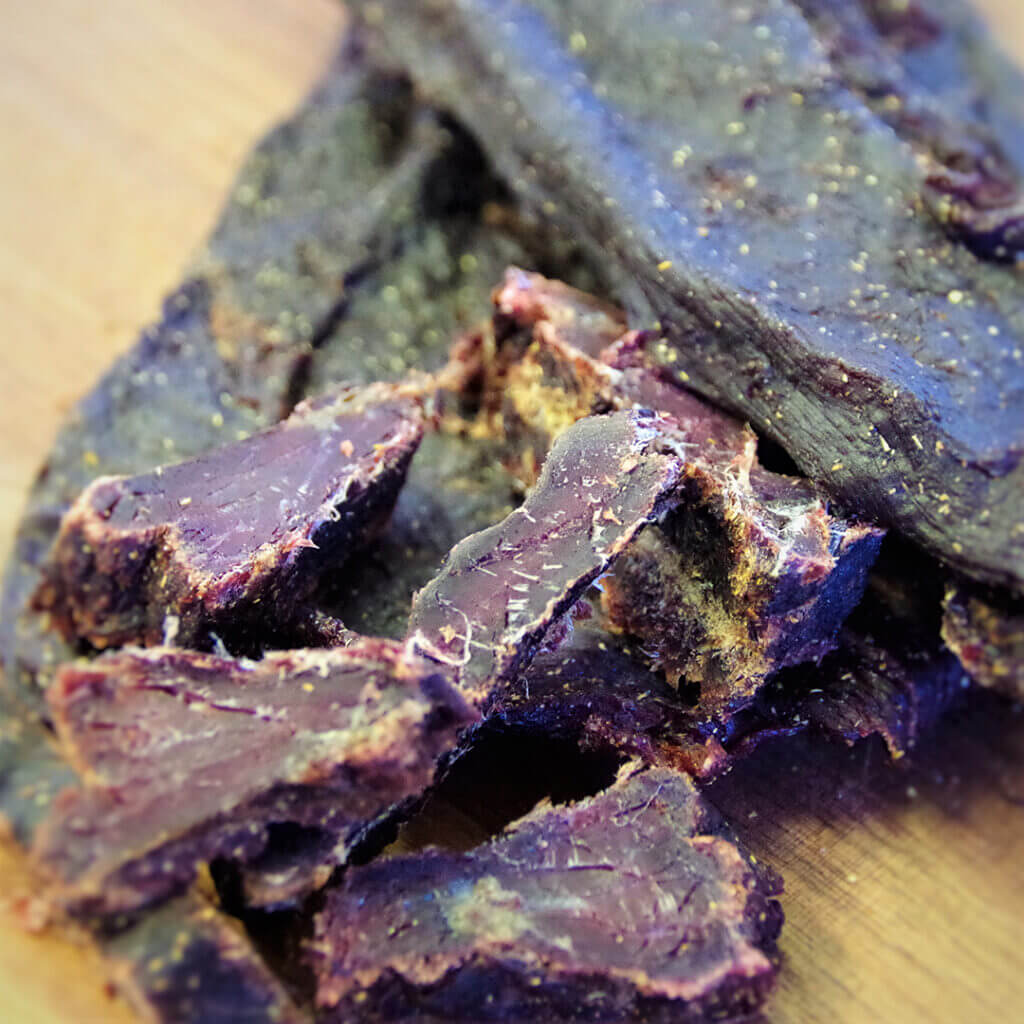
If biltong and jerky were to have a showdown, they’d have to share the podium. It’s impossible to pick a winner.
Although these two types of dried meat treat are very similar in concept, there are actually some key differences such as where they originated from, the production process, their nutritional profiles and the taste and texture. It a bit like that old saying – same, same but different!
If you’ve sampled biltong and jerky, you’ll know what we mean – but let’s have a drumroll for a mouth-watering showdown between our two favourite dried meat snacks – beef biltong and beef jerky!
Let’s look at their points of difference and see how each one measures up.
The two have very different geographical origins which date back centuries.
Biltong originated in South Africa to the time of the early settlers, whereas the roots of jerky can be traced back to the Quecha Indians who lived in the mountains of South America. Both biltong and jerky were borne from a need to survive and dehydration proved to be an excellent option for preserving meat for long treks, extended hunting trips, tough winters etc.
Heat is the primary difference when it comes to making the two products.
Jerky is dried using a heat source whereas biltong is air-dried naturally. With jerky, dehydration generally takes around 6 – 12 hours, but biltong takes days and sometime weeks (depending on the desired ‘dryness’).
As a rule, jerky is made from very lean cuts of meat and whilst it’s also possible to make biltong from a lean cut, it is also utterly delicious when the meat has a higher fat content.
To make jerky, the meat is first sliced into long, narrow strips and then marinated for around 24 hours in a variety of ingredients to achieve different flavour profiles. On the other hand, biltong is made by curing large chunks of meat in a mixture of vinegar, salt and spices before hanging these out to dry. The chunks are then sliced into the desired size.
Neither process is better than the other. They’re just different and we love that about them.
The components of biltong are relatively simple (vinegar, salt, spices) whereas jerky marinades often comprise a greater array of ingredients and seasonings which can include sugar. Both are packed full of protein and contain a plethora of other important minerals and vitamins such as iron, zinc, Vitamins B6 and B12, magnesium and potassium.
Depending on the cut used for the biltong (and how much of the fatty outside layer is left on the meat), biltong can have a higher natural fat content.
These two meaty treats are also low in carbohydrates, so they’re a healthy option over carb-heavy snacks like crackers and crisps.
As with most things in life, the key is moderation and you can always check the label on the packaging to get a more accurate breakdown of your biltong or jerky’s nutritional make-up.
Is it possible to pick a winner between jerky and biltong in terms of flavour and texture? We don’t think so, but that’s not to say you can’t have your favourite!
The overall taste depends on the specific flavourings used and the production process. For example, you’ll often find smoked beef jerky, whereas smoked biltong is a rarity. The vinegar and spice mix of biltong tends to be traditional and is usually quite simple, leaving the end product with a naturally meaty flavour with a subtle hint of acidity from the vinegar or cider.
On the flip side, there are many different flavour variations when it comes to the sauces and marinades using for making jerky such as Cajun, curry, sweet and sour, smoky honey and barbeque.
In terms of texture, jerky tends to have a chewier, dryer texture because of the leanness of the meat and the drying method. With biltong, the texture can vary considerably depending on the cut of meat used and the level of dehydration (eg dry biltong, medium dry biltong, moist biltong, snapsticks) but it is generally softer than jerky.
We can’t pick a winner when it comes to our two favourite dried meats. We love them equally. We also put an equal amount of care and attention into making both of these sensational snacks (which is a LOT!) – and that’s probably why DJays Gourmet is known for making the best beef biltong AND beef jerky in Australia.
But if you want put them to the test and have your own biltong vs jerky showdown, simply order your beef jerky or beef biltong online and we’ll have them delivered to your door in a flash. Let the games begin!
Arron Zamel has been General Manager of DJays Gourmet since 2015 and under his expert leadership, the company has cemented its reputation as Australia’s leading supplier of packaged jerky and biltong.
His strong family connection to South Africa, his marketing and management degree from Monash University, his technical expertise plus his experience as a successful entrepreneur and import/export business owner made him the ideal candidate for the challenging position.
Additionally, Arron’s innovative approach to management, his proven brand-building credentials, his strong customer focus and youthful energy have ensured that DJays Gourmet’s high-quality biltong and jerky have become Australia's dried meat treats of choice.
He understands traditional South African flavours and the precision techniques required to create truly authentic biltong, jerky and droewors (dried sausage). Part of his job is overseeing operations at DJays' purpose-built facility in Perth, WA where tons of Australian beef goes into making premium dried meat products each month for distribution to retail and wholesale customers across Australia.
For more insights into Arron’s world, visit the DJays Gourmet website, check out their Facebook page or follow them on Instagram @djaysgourmet.
* Terms & Conditions
Sale excludes sale items and other discount coupons. Sale ends midnight 10 May 2025.
© Copyright 2025 D.Jays Gourmet. All Rights Reserved | ABN 14 103 055 296 | Privacy Policy